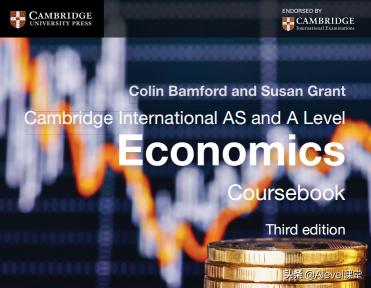A-leveleconomicsrevisionguidesandquestionbankscoveringlabourmarkets,supplyanddemand,marketstructureandallcoreeconomicsa-

A-level economics revision guides and question banks covering labour markets, supply and demand, market structure and all core economics a-level topics.
以下內容我們會持續更新:
今天帶給大家Alevel經濟筆記是:
第三章:Elasticities—
Cross Price Elasticity of Demand Formulae;
Cross Price Elasticity of Demand
A definition and the formula
If you understand the concept of price elasticity of demand, then it is fairly easy to grasp cross price elasticity of demand.
The issue is still how responsive demand is to a given price change, the difference here is that one is measuring the responsiveness of the quantity demanded of one good with respect to a given price change in a different good, ceteris paribus.
如果你理解了需求價格彈性的概念�����,那么理解需求的交叉價格彈性是相當容易的。問題仍然是需求對給定價格變化的響應程度��,這里的區別在于衡量一種商品的需求量相對于另一種商品的給定價格變化的響應性���,其他條件不變����。
As you can see, the formula used to calculate the cross price elasticity of demand is basically the same as the one used to calculate the price elasticity of demand, except for the distinction between good A and good B:
可以看到,計算需求交叉價格彈性的公式與計算需求價格彈性的公式基本相同��,除了商品A和商品B的區別:
Where:
EY = The income elasticity of demand
Δ = 'change in'
Qd = Quantity demanded
Y = Real income
Substitute, complement and independent goods
替代品���、互補品和獨立品
The cross price elasticity of demand is useful for economists because it tells you whether two goods (A and B) are substitutes, complements or even unrelated.
Think about this example:
需求的交叉價格彈性對經濟學家很有用��,因為它可以告訴您兩種商品(A 和 B)是否是替代品��、互補品,甚至是不相關的��。想想這個例子:
Tea and coffee are substitutes.
Let's say that tea is good A and coffee is good B. If the price of coffee falls by, say, 10% ceteris paribus, then one would expect coffee to become relatively more popular at the expense of the demand for tea.
The demand for tea might fall by, say, 5%. Using the formula above, we can calculate the cross price elasticity:
茶和咖啡是替代品。假設茶是好的 A,咖啡是好的 B。如果咖啡的價格下降,比如說,在其他條件不變的情況下下降 10%��,那么人們會期望咖啡變得相對更受歡迎�,但會犧牲對茶的需求。對茶的需求可能會下降 5%。使用上面的公式��,我們可以計算交叉價格彈性:
Briefly, the price of coffee falls, so the demand for tea falls. This is a positive relationship, as is true for all pairs of goods that are substitutes.
If the cross price elasticity of demand is positive then the two goods in question will be substitutes.
簡而言之���,咖啡價格下跌��,因此對茶的需求下降�����。這是一種正向關系�,對于所有可替代的商品對都是如此。如果需求的交叉價格彈性為正��,那么這兩種商品將是替代品�����。
Tea and sugar are complements. Sugar is a complement to a cup of tea (for some people, anyway!).
Assume that sugar is good A and tea is good B. If the price of tea fell by, say, 10% ceteris paribus, then one would expect the demand for tea to rise.
This should cause the demand for sugar to rise, although not everyone has sugar in their tea, and if they do the quantities are not exactly massive, so the rise in demand for sugar is likely to be a lot smaller than the rise in demand for tea. Let's say that the demand for sugar rises by 2%. Using the formula, we have:
茶和糖是互補的����。糖是一杯茶的補充(對某些人來說���,無論如何?����。?���。假設糖是好的 A�����,茶是好的 B�����。如果茶的價格下降,比如說�����,在其他條件不變的情況下下降 10%��,那么人們會預期對茶的需求會上升。這應該會導致對糖的需求上升,盡管不是每個人的茶中都有糖���,而且如果他們這樣做,數量也不是很大,所以對糖的需求增長可能比對糖的需求增長要小得多�����。茶�����。假設對糖的需求增加了 2%��。使用公式,我們有:
Put briefly, the price of tea falls, so the demand for sugar rises. This is a negative relationship, as is true for all pairs of goods that are complements.
If the cross price elasticity of demand is negative then the two goods in question will be complements.
簡而言之,茶葉價格下跌�,因此對糖的需求增加��。這是一種負關系,對于所有互補的商品對都是如此�。如果需求的交叉價格彈性為負��,那么這兩種商品將是互補品。
What will happen to the demand for sugar when the price of cinema admissions changes, ceteris paribus? Absolutely nothing, I should think. The two goods are completely unrelated. Using the formula:
在其他條件不變的情況下�����,當電影院門票價格發生變化時�����,糖的需求會發生什么變化��?絕對沒有���,我應該想。這兩種商品完全不相關。使用公式:
If the cross price elasticity of demand is zero then the two goods in question will be totally unrelated (or independent).
如果需求的交叉價格彈性為零��,那么所討論的兩種商品將完全不相關(或獨立)�。
Finally, note that the higher the value of the cross price elasticity, the stronger the relationship between the two goods in question, whether they be substitutes of complements.
The nearer the figure is to zero, the more likely that the two goods are unrelated.
最后,請注意交叉價格彈性的值越高,這兩種商品之間的關系越強�����,無論它們是否是互補品的替代品����。該數字越接近于零,兩種商品不相關的可能性就越大。
今天的Alevel經濟筆記就更新到這里,如果大家對Alevel經濟學感興趣可以關注我們����,
關于Alevel經濟筆記第三章:Elasticities后續的更新計劃如下:

